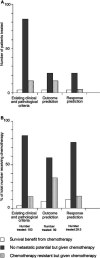Molecular profiling of breast cancer: clinical implications
- PMID: 15026788
- PMCID: PMC2409657
- DOI: 10.1038/sj.bjc.6601667
Molecular profiling of breast cancer: clinical implications
Abstract
Breast cancers are routinely subcategorised on the basis of clinical stage, cellular morphology and immunohistochemical analysis of a small number of markers. The recent development of gene expression microarray and related technologies provides an opportunity to perform more detailed profiling of the disease. It is anticipated that the molecular classification arising from such studies will be more powerful than its pathological predecessor at confining treatment to those patients who are most likely to benefit. It is likely that this will result in a much less frequent use of adjuvant chemotherapy. Furthermore, of those who do receive it, a higher proportion will benefit. If adopted, this will offer considerable patient benefits in terms of reducing unnecessary toxicity and have major health economic implications.
Figures

References
-
- Aubele M, Mattis A, Zitzelsberger H, Walch A, Kremer M, Welzl G, Hofler H, Werner M (2000) Extensive ductal carcinoma In situ with small foci of invasive ductal carcinoma: evidence of genetic resemblance by CGH. Int J Cancer 85: 82–86 - PubMed
-
- Bernards R, Weinberg RA (2002) A progression puzzle. Nature 418: 823. - PubMed
-
- Chang JC, Wooten EC, Tsimelzon A, Hilsenbeck SG, Gutierrez MC, Elledge R, Mohsin S, Osborne CK, Chamness GC, Allred DC, O'Connell P (2003) Gene expression profiling for the prediction of therapeutic response to docetaxel in patients with breast cancer. Lancet 362: 362–369 - PubMed
-
- Cleator S, Parton M, Dowsett M (2002) The biology of neoadjuvant chemotherapy for breast cancer. Endocr Relat Cancer 9: 183–195 - PubMed
Publication types
MeSH terms
Grants and funding
LinkOut - more resources
Full Text Sources
Other Literature Sources
Medical

